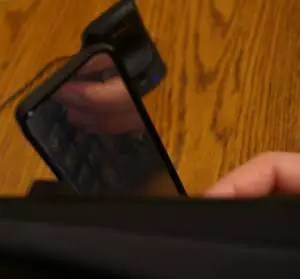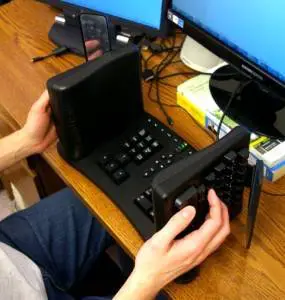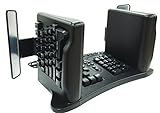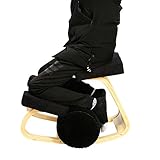The SafeType vertical ergonomic keyboard is new to my desktop, but not to my ergonomic radar screen. I’ve been watching this curious concertina-like invention for years, but up until recently my efforts toward acquiring a sample were in vain. That situation recently changed, and thus I am typing these words with my hands in the most curious position a standard-trained typist could possibly imagine.
Safetype Keyboard: the method behind the madness
Why would you want a vertical keyboard? Same reason you’d want a vertical mouse – to un-twist your wrists and lift your palms to a more “natural” position. Most ergonomic keyboards are in fact aiming at this same goal to some degree, but (with one exception) they don’t take it nearly as far.
According to a video on SafeType’s website, any wrist angle less than vertical is “unacceptable.” All other design considerations are sublimated to this priority. The resulting keyboard is surprisingly usable for its weird appearance but makes certain sacrifices of convenience that some people may not be willing to deal with.

The mirrors (not correctly adjusted here) enable you to see the function key row and numbers while typing.
View in the mirror: how it works
The SafeType has one feature more commonly associated with the automotive industry: rear-view mirrors. Don’t get excited; these mirrors won’t help you see when your supervisor is sneaking up on you. They’re intended to let you see your own fingers while typing – at least while typing on the number and function key rows, which actually have their legends printed backward to appear correctly when reflected.
Swinging on thin, stiff plastic arms, the SafeType’s mirrors aren’t exactly the definition of sturdiness. There’s even a leaflet at the top of the box warning that you shouldn’t try to deploy the mirrors from their folded position without reading the instructions first, lest you break them. I can only echo that warning (hypocritically because I didn’t follow it myself- but then, this was a free sample). I did feel like I was breaking the mirrors when I bent the outmost joint, which is why you’ll see it straight in the pictures.
The SafeType’s mirrors won’t likely prove necessary unless you frequently access the function keys along the top row of your keyboard. Touch-typing courses don’t normally teach these, so we tend to hunt and peck. The mirrors are also handy for peeking a little when trying to find the star key, parentheses, etc. The ones on mine look a little cheap and foggy, but they do the job.
What do Kinesis, Microsoft, and SafeType have in common?
On most keyboards the backspace key is inconviently located at the far end of a right-hand pinkie reach, creating a built-in punishment for careless typing. If you use Backspace as much as I do, this can get really tiresome. As a split keyboard, the SafeType implements an interesting idea first used by Kinesis and then later adopted by Microsoft: the left half of the spacebar becomes Backspace. Hence no more reaching!
Now, having Backspace under your left thumb isn’t all roses. In fact, it can be quite a thorn at first. The problem is that most of us tend to alternate thumbs when we press the spacebar. When one of these thumbs suddenly begins to produce a backspace instead of a space, the result can be a real mess. I remember facing this with the Kinesis Advantage when I took it for a month-long test drive, and I found it once again a bit confusing on the SafeType.
 Think, don’t think
Think, don’t think
Overall, I’ve found adjusting to the SafeType to be rather quicker and easier than I would have expected – certainly no harder than adjusting to the Kinesis Advantage or Truly Ergonomic Keyboard when I used those before. Obviously, if you aren’t a touch typist, you shouldn’t be thinking about getting an ergonomic keyboard anyway; you should probably be thinking about learning to type instead.
If you are one of those who can already type blindfolded, don’t think at all. That’s right – don’t think. The first time you encounter a SafeType, your brain will be screaming, “Whoa! Where am I? What is this?” Your fingers, on the other hand, don’t have the disadvantage of sight. They will say, “Hmm… seems like everything is pretty much where it was before. Let’s get typing!” As long as you shush your brain and listen to your muscles, you should be fine (apart from the aforementioned backspace thing, which bugs me even though I’ve experienced it before). The very same skills that enable you to type on a flat keyboard will enable you to function naturally on a SafeType.
Run-of-the-mill key switch action
SafeType asserts passionately on its website that key force doesn’t matter. While I have my doubts about the validity of this claim, there is at least no question that the company is consistent. In contrast to other ergonomic keyboards, which advertise low-force membrane or even mechanical key switches, SafeType proudly presents you with Any Old Keyswitches, the brand of choice for those who believe that keystroke force is “an imaginary problem.” The SafeType key action is exactly the same as you would get on a freebie keyboard, so if you like the way any old keyboard feels under your fingers, you’ll be fine.
What you can and can’t do on a SafeType
As discussed above, it’s very easy to type words, paragraphs, pages, and books on a SafeType, because the alphanumeric keys and punctuation are exactly where they’ve always been in relation to your hands. The problem is with those other keys – the ones you probably use all the time but never think about.
For example, I use the arrow keys, Home, and End constantly when editing text, a method that is indescribably more efficient than constantly reaching for the mouse. With SafeType, these keys are between the two halves of the keyboard, and thus hopelessly out of reach when your hands are in the typing position. Even Delete lives in this inaccessible gorge, leaving the hapless touch typist with two backspace keys but no Delete. Again this is fine if you’re writing big reams of text, but not so handy if you need to navigate through an existing document.
Because of the above concerns with “helper” keys, I’d be cautious about recommending the SafeType to a programmer or editor. In my view, this keyboard is best suited to writers and transcriptionists – people who type lots of text all day long and want to try a vertical wrist position. For this narrow segment of the market, SafeType could be just the thing.
Disclosure: This review was made with a sample from SafeType, which I returned later.







